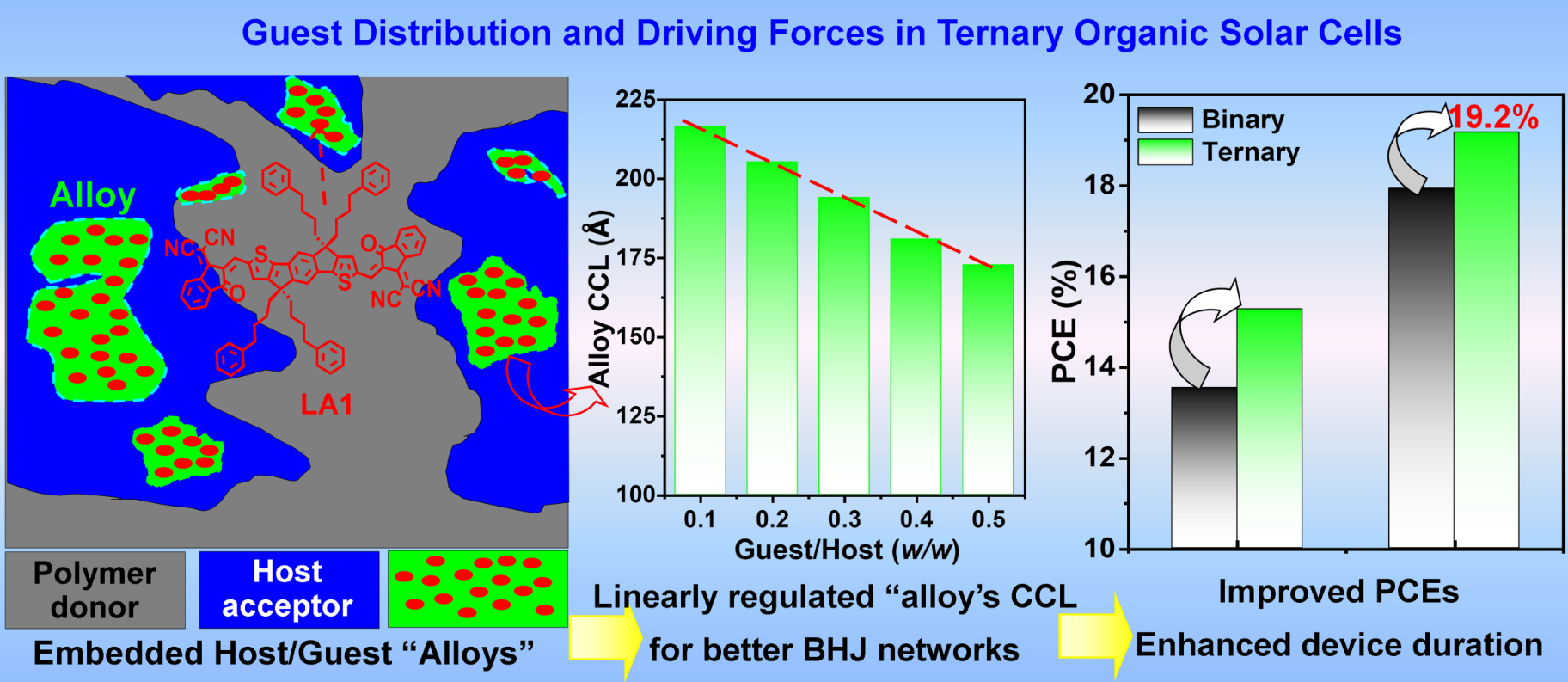Ternary organic solar cells (TOSCs) have recently had their material modified by researchers from the Qingdao Institute of Bioenergy and Bioprocess Technology (QIBEBT) of the Chinese Academy of Sciences (CAS), who have reached efficiencies similar to those of their conventional solar cell cousins.
 Illustration of the embedded host/guest ‘alloys’ aggregations in ternary-component active layer. Image Credit: LI Yonghai
Illustration of the embedded host/guest ‘alloys’ aggregations in ternary-component active layer. Image Credit: LI Yonghai
On July 31st, 2023, the findings were published in Advanced Materials.
Organic photovoltaic solar cells (OSCs) are a type of solar cell that converts sunlight into electricity using organic materials, often small molecules or polymers, as opposed to classic inorganic solar cells, which employ crystalline silicon or other inorganic materials.
One of the primary benefits of OSCs is their versatility and lightweight. They can be produced in flexible rolls rather than rigid panels at a lower cost utilizing solution-based technologies such as inkjet printing, making them appropriate for a wide range of applications such as sensors, portable chargers, and wearable electronics. OSCs can also be semi-transparent or colored, enabling aesthetic incorporation into buildings, windows, and other structures.
OSCs, on the other hand, have lower power conversion efficiency (PCE) than inorganic solar cells. TOSCs have helped to improve the problem. Unlike standard binary organic solar cells, which are made up of a donor and an acceptor material, TOSCs have a third component known as the “guest.”
This guest component is included to enhance different elements of the solar cell’s performance, such as modifying the cell’s internal energy fluxes and optimizing how the cell converts light into power.
The guest component, which is particularly interesting for PCE increases, can further widen the spectrum of light that can be absorbed. The overall sunlight absorption of the cell can be improved by selecting a guest material that absorbs light in a region not covered by the donor or acceptor. Meanwhile, the morphology of the blend film, where exciton dissociation, charge production, and transport proceed, can be fine-tuned.
Given the numerous varied activities that the guest component might perform, its precise placement within the solar cell ‘sandwich’ or matrix can have a significant impact on performance.
Depending on its placement, the guest component can either transfer energy lightning-fast or help capture more sunlight.
Yonghai Li, Study Co-Author and Professor, Chinese Academy of Sciences
There are three possible placements: immersed in the donor material, embedded in the acceptor material, or scattered in some way across the donor and acceptor interfaces, generating blended, alloy-like structures (aggregations). However, until recently, relatively little thought has been given to experimenting with guest component positions.
In their study, the researchers employed a guest component termed LA1 in the TOSC (which varies from other guest component materials in terms of crystallinity). LA1 is a small molecule acceptor that the researchers modified with phenylalkyl side chains—a functional group (a group of atoms within a molecule that has its own set of characteristics) that is often employed in the construction of organic materials for use in photovoltaic systems.
The LA1 was changed with a phenylalkyl side chain to increase crystallinity and alignment while maintaining adequate compatibility, resulting in improved TOSC performance.
Furthermore, the researchers controlled the distribution of their guest components by varying the variables that affect interaction with the host components, such as host/guest compatibility, surface energy, crystalline dynamics, and intermolecular interactions. They discovered alloy-like aggregations within the majority of the guest molecules, which infiltrated and disseminated throughout the host molecules.
The crystalline size of these integrated host/guest 'alloys' can be easily fine-tuned for enhanced electric charge transport and charge recombination suppression. As a consequence, the researchers were able to obtain PCE increases of more than 15% initially and subsequently achieved even bigger efficiency gains of more than 19% by combining their guest component with the Y6 family of acceptors as the host component.
The researchers believe they have had significant experimental success, but the theoretical drivers of these benefits are less well understood. The researchers want to better understand these fundamental systems in the future.
Journal Reference:
Wang, X., et al. (2023) Embedded Host/Guest Alloy Aggregations Enable High-Performance Ternary Organic Photovoltaics. Advanced Materials. doi:10.1002/adma.202305652